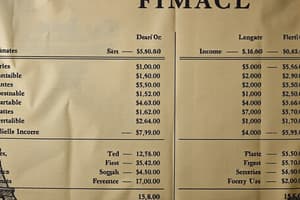Podcast
Questions and Answers
Which of the following is NOT considered a current asset?
Which of the following is NOT considered a current asset?
- Property, plant, and equipment (correct)
- Prepaid expenses
- Accounts receivable
- Inventory
Which of the following expenses is NOT typically included in the cost of goods sold (COGS) for a manufacturing company?
Which of the following expenses is NOT typically included in the cost of goods sold (COGS) for a manufacturing company?
- Production overhead costs
- Payroll taxes (correct)
- Material costs
- Labor costs
What is the main purpose of the equity section in a company's balance sheet?
What is the main purpose of the equity section in a company's balance sheet?
- To show the company's total liabilities
- To show the residual interest in the company's assets after deducting liabilities (correct)
- To show the company's total assets
- To show the company's retained earnings
Which of the following would NOT be considered a type of liability for a company?
Which of the following would NOT be considered a type of liability for a company?
Which of the following expense items is NOT typically included in the income statement?
Which of the following expense items is NOT typically included in the income statement?
Which of the following is considered a non-current asset?
Which of the following is considered a non-current asset?
Which of the following is a typical category for recording revenue in an income statement?
Which of the following is a typical category for recording revenue in an income statement?
What is the purpose of a contra account like Sales Discounts?
What is the purpose of a contra account like Sales Discounts?
Which of the following would NOT be considered an asset on a company's balance sheet?
Which of the following would NOT be considered an asset on a company's balance sheet?
What is the primary purpose of the equity section on a company's balance sheet?
What is the primary purpose of the equity section on a company's balance sheet?
If a company's total liabilities exceed its total assets, what does this indicate?
If a company's total liabilities exceed its total assets, what does this indicate?
Which of the following accounts would typically be included in the expenses section of an income statement?
Which of the following accounts would typically be included in the expenses section of an income statement?
Study Notes
Account Titles in Income Statement and Balance Sheet
Overview
Understanding account titles in an income statement and balance sheet is crucial for interpreting the financial health of a company. Both statements use a standard set of account labels to categorize financial events. Here we'll explore the main types of accounts included in these statements: revenue, expenses, assets, equity, and liabilities.
Revenue
Revenue accounts are used to record income from the sale of products or services that a company provides for its customers. These accounts can be further segmented into various subcategories such as sales revenue, service revenue, interest income, rental income, etc., depending on the nature of the business activities. For example, a retail store may have a 'sales revenue' account to track total cash inflow from selling merchandise, while a software development firm might have separate accounts for 'licensing fees revenue', 'software maintenance revenue', and 'royalties revenue'.
Sales Discounts
Sales discounts are a contra account subtracted from gross sales. They represent reductions granted by companies to customers that reduce the overall amount of revenue earned. This could include bulk purchase incentives or discounts given due to longer payment terms.
Expenses
Expenses are recorded under this category to reflect all costs incurred during the reporting period to generate those revenues. Some common expense accounts that businesses often use include cost of goods sold (COGS), compensation expense, depreciation and amortization expense, employee benefits, insurance expense, marketing expenses, office supplies expense, payroll taxes, professional fees, rent expense, repairs and maintenance expense, taxes, travel and entertainment expense, utilities expense, and income taxes.
Cost of Goods Sold
Cost of goods sold (COGS) represents the direct costs attributable to manufacturing or purchasing goods which are later sold to customers. This includes material costs, labor costs, production overhead costs, and other indirect costs associated with bringing the product to market.
Assets
Assets typically represent items owned by the company that provide future economic benefit. There are two main types of assets - current and non-current. Current assets are expected to be converted into cash within one year, while non-current assets are not.
Current Assets
Current assets include cash, cash equivalents, inventory, prepaid expenses, and accounts receivable.
Non-Current Assets
Non-current assets are long-term assets such as property, plant, and equipment (PP&E), intangible assets, and other long-term investments.
Equity
Equity represents the residual interest in the assets of a company after deducting liabilities. It is calculated as the difference between total assets and total liabilities. The equity section includes common stock, retained earnings, additional paid-in capital, treasury stock, and other equity items.
Liabilities
Liabilities are financial obligations that a company owes to external parties. These include accounts payable, accrued expenses, short-term loans, long-term debt, and deferred tax liabilities.
Conclusion
Understanding account titles in an income statement and balance sheet is essential for interpreting a company's financial health. Each account title serves a specific purpose, and these categories enable financial analysts to accurately assess a company's financial position and performance. By analyzing these statements, investors can make informed decisions about the company's financial viability and future prospects.
Studying That Suits You
Use AI to generate personalized quizzes and flashcards to suit your learning preferences.
Description
Learn about the different account titles in an income statement and balance sheet, including revenue, expenses, assets, equity, and liabilities. Explore how these accounts are categorized and what they represent in a company's financial statements.




